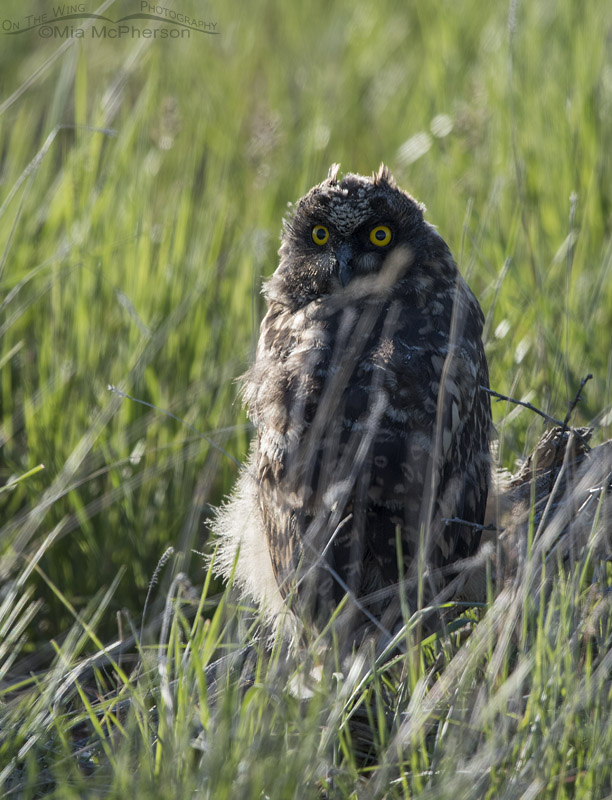 Very young Short-eared Owl chick – Nikon D810, f6.3, 1/800, ISO 400, -0.3 EV, Nikkor 500mm VR with 1.4x TC, natural light, not baited
Very young Short-eared Owl chick – Nikon D810, f6.3, 1/800, ISO 400, -0.3 EV, Nikkor 500mm VR with 1.4x TC, natural light, not baited
This year was exceptional for photographing Short-eared Owls in Utah, Idaho and Montana and being able to see them in all the stages of their growth.
Short-eared Owls nest on the ground and their chicks disperse from their nests about 12 to 18 days after hatching and at that point they aren’t able to fly. It is thought that they move away from the nest as young as they do to evade predators.
This isn’t a great photo because of the lighting but this was the first Short-eared Owl chick I spotted this year. I had to take the photo.
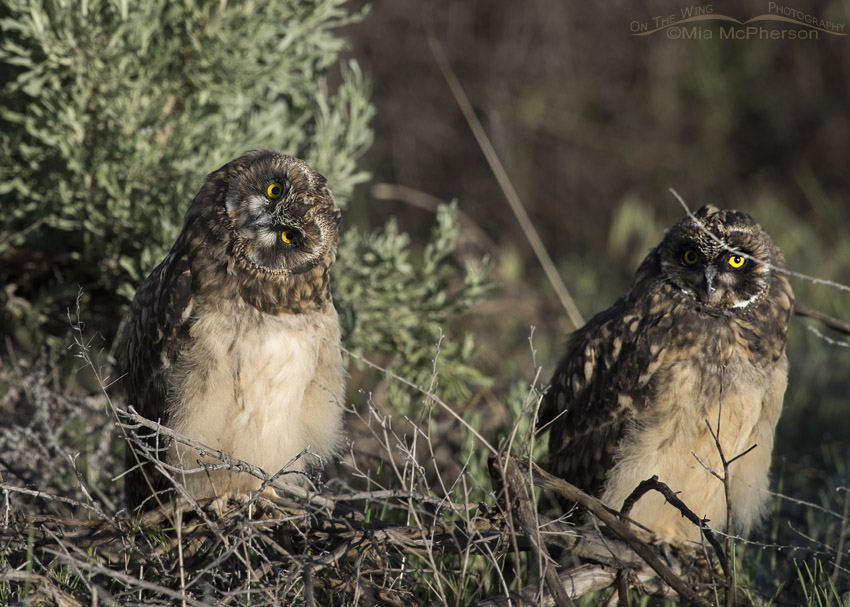 Short-eared Owl chicks in morning light – Nikon D810, f7.1, 1/640, ISO 250, -0.7 EV, Nikkor 500mm VR with 1.4x TC, natural light, not baited
Short-eared Owl chicks in morning light – Nikon D810, f7.1, 1/640, ISO 250, -0.7 EV, Nikkor 500mm VR with 1.4x TC, natural light, not baited
I didn’t know that just five days later in the same general location that I would come across not just one Short-eared Owl chick but three of them close enough to photograph in soft morning light. They watched at me as I photographed them from my Jeep and they might have been as curious about me as I was delighted to see them.
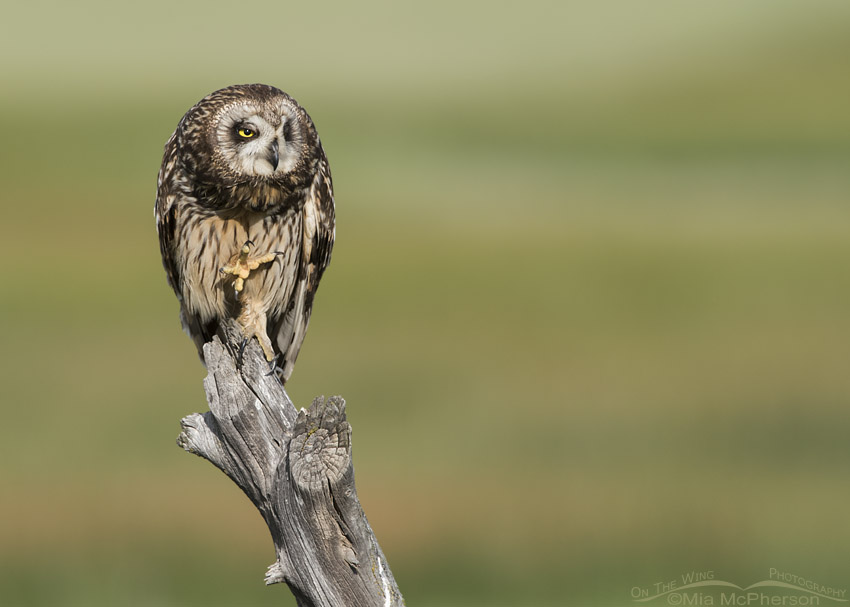 Female Short-eared Owl with open talons – Nikon D810, f9, 1/640, ISO 400, Nikkor 500mm VR with 1.4x TC, natural light, not baited
Female Short-eared Owl with open talons – Nikon D810, f9, 1/640, ISO 400, Nikkor 500mm VR with 1.4x TC, natural light, not baited
Later that same morning I found more Short-eared Owls north of where the chicks had been and this adult female was perched out in the open near a wet meadow where she preened and stretched not too far from the road. I could hear chicks hissing in grasses nearby but I never saw them.
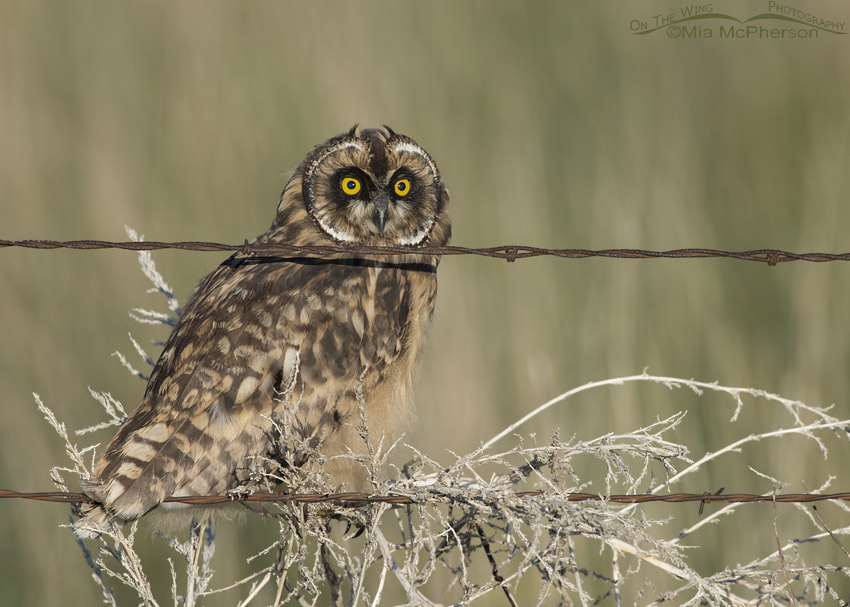 Short-eared Owl chick on a barbed wire fence – Nikon D810, f9, 1/1000, ISO 500, -0.3 EV, Nikkor 500mm VR with 1.4x TC, natural light, not baited
Short-eared Owl chick on a barbed wire fence – Nikon D810, f9, 1/1000, ISO 500, -0.3 EV, Nikkor 500mm VR with 1.4x TC, natural light, not baited
Three days later I found more Short-eared Owls chicks in a third location but never did get an image of them where the view of them wasn’t obstructed by fences or grasses but I was happy all the same. I loved how this image shows the ear tufts slightly raised on this chick.
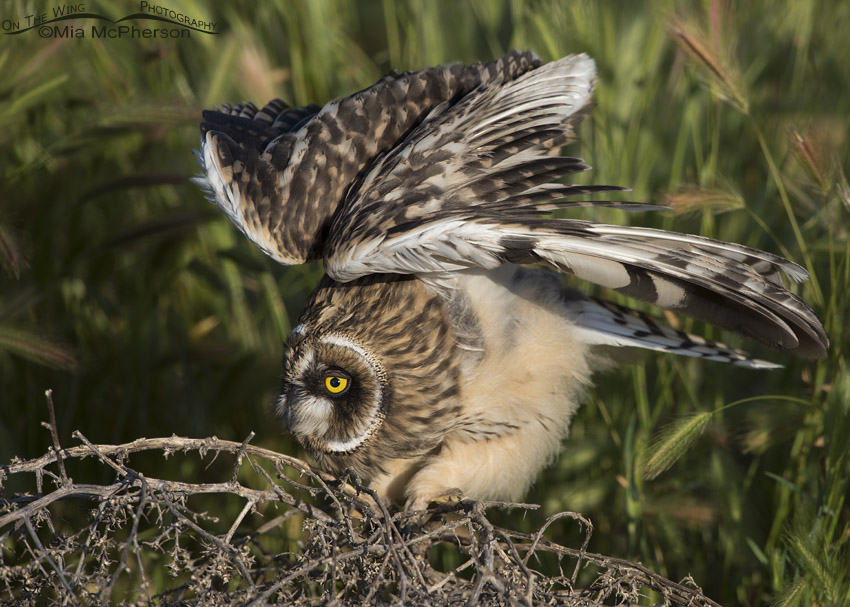 Fledgling Short-eared Owl lifting its wings – Nikon D810, f7.1, 1/1000, ISO 320, -0.7 EV, Nikkor 500mm VR with 1.4x TC, natural light, not baited
Fledgling Short-eared Owl lifting its wings – Nikon D810, f7.1, 1/1000, ISO 320, -0.7 EV, Nikkor 500mm VR with 1.4x TC, natural light, not baited
And four days later I was able to get photographs of fledglings in the same area where there wasn’t a thing obstructing the view of the owls. They were able to fly by this time.
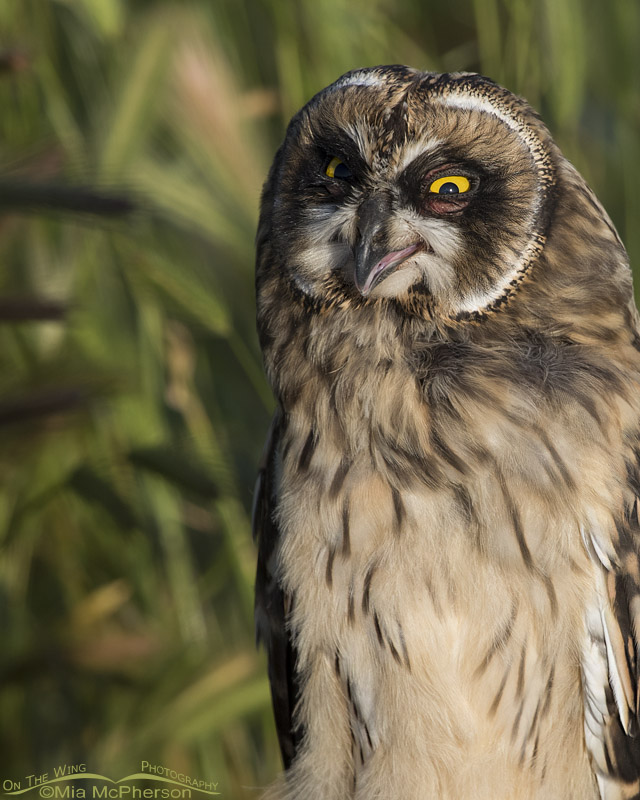 Short-eared Owl fledgling fluttering its gular sac – Nikon D810, f7.1, 1/1000, ISO 320, -1.0 EV, Nikkor 500mm VR with 1.4x TC, natural light, not baited
Short-eared Owl fledgling fluttering its gular sac – Nikon D810, f7.1, 1/1000, ISO 320, -1.0 EV, Nikkor 500mm VR with 1.4x TC, natural light, not baited
And I was also able to take a few portraits of the Short-eared Owl fledglings including this one where it looks like the young owl was smiling but was in fact fluttering its gular sac or pouch to cool itself off.
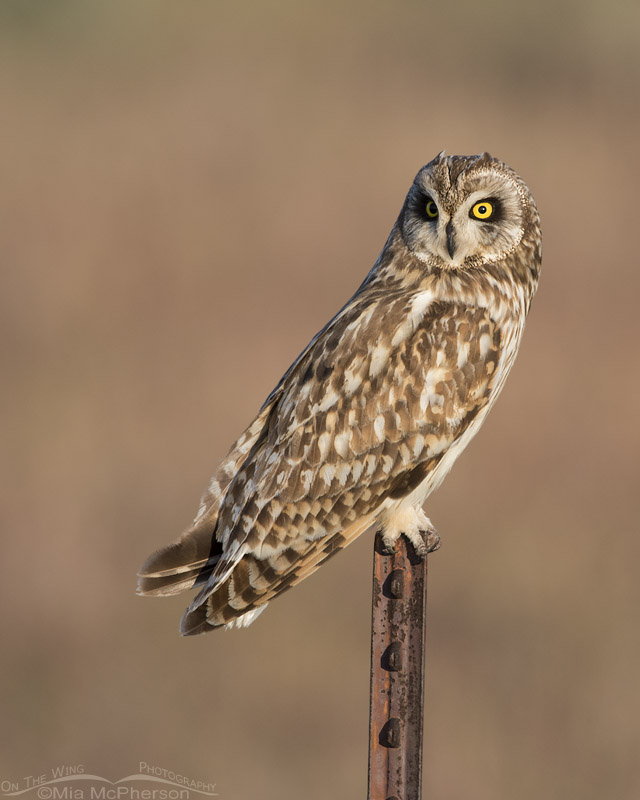 Adult male Short-eared Owl on a rusty metal post – Nikon D810, f7.1, 1/800, ISO 500, Nikkor 500mm VR with 1.4x TC, natural light, not baited
Adult male Short-eared Owl on a rusty metal post – Nikon D810, f7.1, 1/800, ISO 500, Nikkor 500mm VR with 1.4x TC, natural light, not baited
In another location on that same morning this handsome adult male Short-eared Owl perched on a rusty metal post in beautiful light. It may have had chicks or fledglings nearby but I couldn’t see them in the tall grasses and sagebrush.
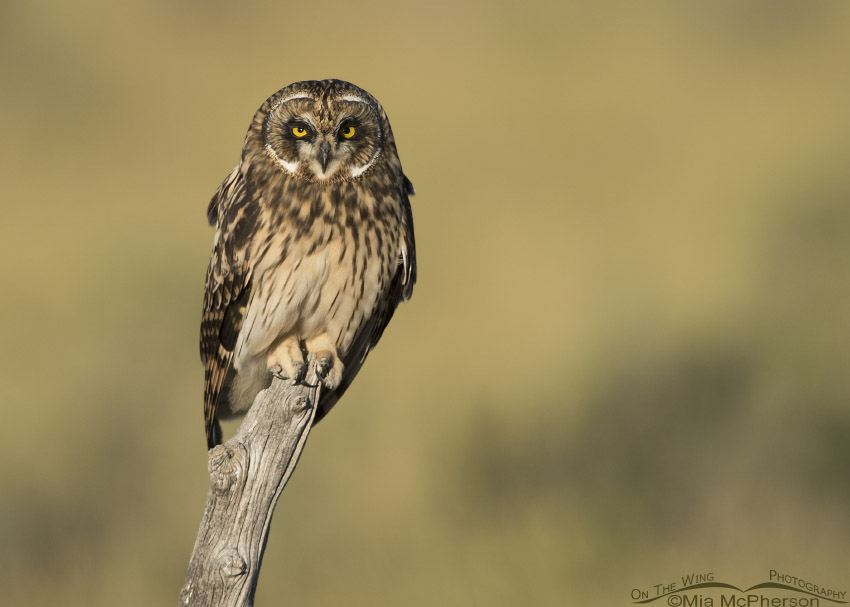 Fledgling Short-eared Owl perched on a gnarly post – Nikon D810, f6.3, 1/1000, ISO 400, Nikkor 500mm VR with 1.4x TC, natural light, not baited
Fledgling Short-eared Owl perched on a gnarly post – Nikon D810, f6.3, 1/1000, ISO 400, Nikkor 500mm VR with 1.4x TC, natural light, not baited
I continued to find Short-eared Owls and their young throughout the summer in northern Utah and every time I photographed them I realized how fortunate I am to be able to photograph these beautiful owls and share my excitement about them with my family, friends, all of you who read my posts daily and to the world through my photographs.
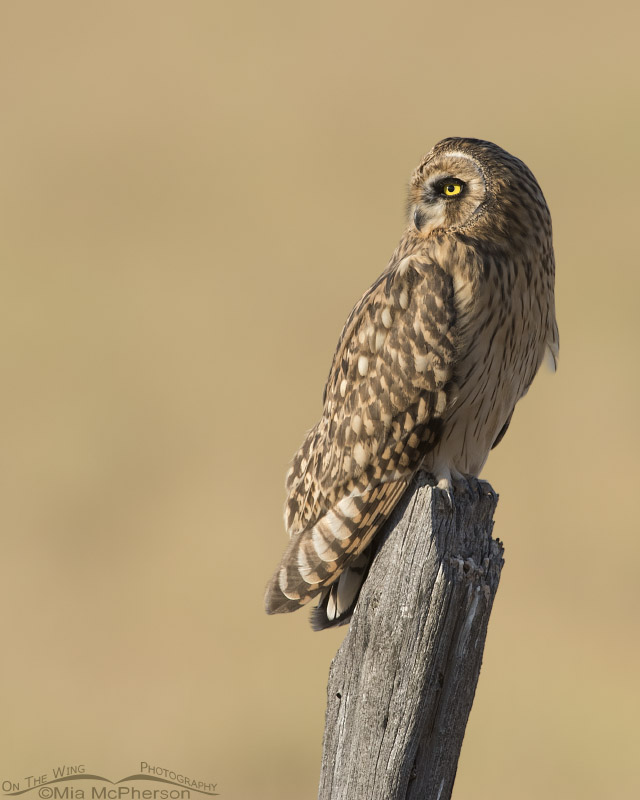 Juvenile Short-eared Owl in northern Utah – Nikon D810, f8, 1/800, ISO 400, Nikkor 500mm VR with 1.4x TC, natural light, not baited
Juvenile Short-eared Owl in northern Utah – Nikon D810, f8, 1/800, ISO 400, Nikkor 500mm VR with 1.4x TC, natural light, not baited
Short-eared Owls chicks grow up much faster than the other larger owls found in North America and I knew that before long they would be hunting much further away from the roads and out of the reach of my lens.
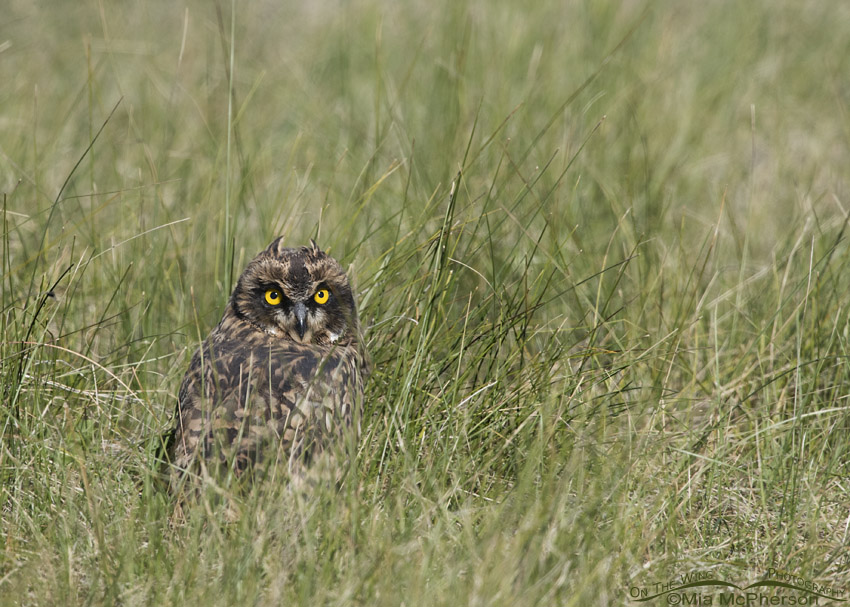 Beaverhead County Short-eared Owl chick – Nikon D810, f6.3, 1/2000, ISO 400, Nikkor 500mm VR with 1.4x TC, natural light, not baited
Beaverhead County Short-eared Owl chick – Nikon D810, f6.3, 1/2000, ISO 400, Nikkor 500mm VR with 1.4x TC, natural light, not baited
But the breeding season comes a bit later in Idaho and southwestern Montana so I was able to photograph Short-eared Owl chicks and fledglings there the middle of July. Short-eared Owl chicks spend a lot of time nearly hidden by the grasses and it takes keen eyes to find them. Once they have the power of flight they do seem to be more visible and spend time perched up higher.
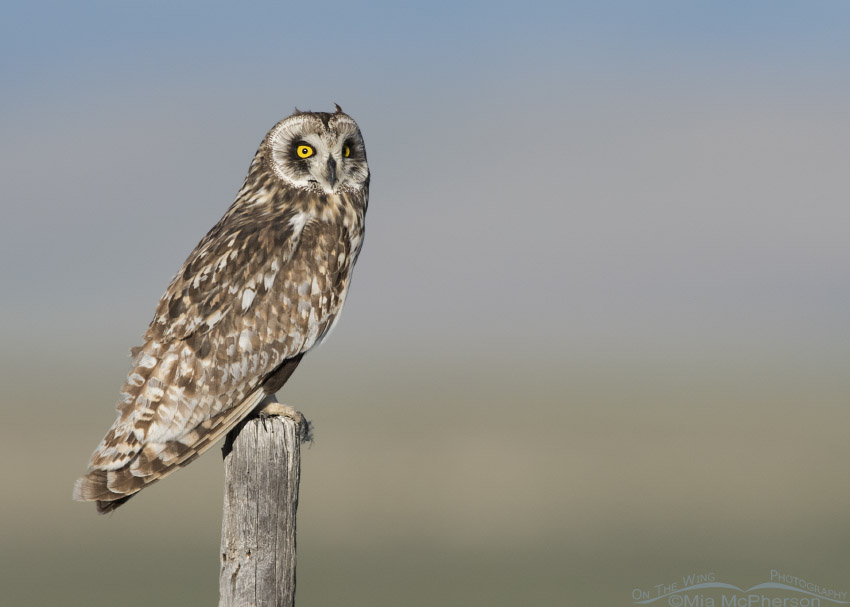 Centennial Valley Short-eared Owl male – Nikon D810, f7.1, 1/1600, ISO 400, +0.3 EV, Nikkor 500mm VR with 1.4x TC, natural light, not baited
Centennial Valley Short-eared Owl male – Nikon D810, f7.1, 1/1600, ISO 400, +0.3 EV, Nikkor 500mm VR with 1.4x TC, natural light, not baited
I spent many hours photographing Short-eared Owls this year and each moment I spent with them was a learning experience that I will truly treasure. Short-eared Owls are fairly nomadic and I might not find them as regularly next year as I did this year. I think I will remember this year as the year of the Short-eared Owls.
Life is good.
Mia
click here to see more of my Short-eared Owl photos plus facts and information about this species.


Wonderful photography and storyline. I learned a lot and what beautiful birds! Great photography Mia! I have not spent time in your part of the country, so it is really enjoyable to see your images. May God continue to bless you and your family and your photography . Brian
Lucky, lucky, lucky you.
Thank you..
Wonderfully informative series Mia!
Boy! What a wonderful morning! Hard to pick favorites…like them all. The youngster in the 6th frame looks like it just heard what it considers a dirty story….I wonder of it has!
Wow, what an amazing series of photos. Wonderful.
Oh my goodness! Those are amazing!
Excellent series and narrative, Mia.
Beautiful photos, Mia. Your Owls are a treasure.
Fascinating birds we seldom see perched. What a wonderful collection Mia. Maybe this year was also a peak year for voles, their major prey.